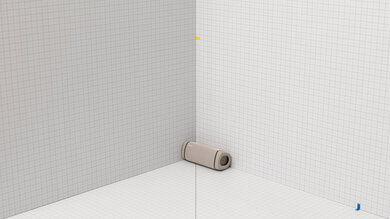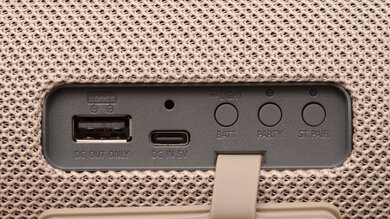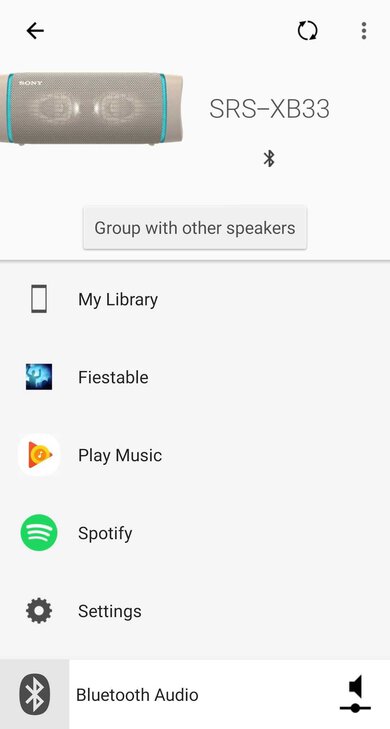The Sony SRS-XB33 is a portable, battery-powered speaker from Sony's EXTRA BASS lineup, with a similar design to the larger Sony SRS-XB43. Like other speakers from this lineup, it comes with customizable RGB lights and is compatible with the Sony Music Center app and Sony's Fiestable app, which lets you access sound customization features, sound effects, and light show effects.
Our Verdict
The Sony SRS-XB33 is mediocre for music. It has an uneven sound profile, and even with its 'EXTRA BASS' preset on, and like most speakers its size, it lacks a thumpy, rumbly low-bass. Vocals and lead instruments also sound a bit veiled and dull at times. That said, you can customize its sound profile thanks to the graphic EQ featured in its companion app. Its soundstage is still perceived as narrow, and it doesn't get very loud.
- Very portable design.
- Graphic EQ and presets.
- Doesn't get very loud.
- Struggles to reproduce low-bass.
The Sony XB33 is sub-par for videos and movies. It struggles to produce a thumpy low-bass commonly found in action-packed movies. It also doesn't get very loud, and its soundstage seems narrow. That said, its companion app has a basic graphic EQ so that you can tweak its sound. It also has low latency on iOS and Android, although some apps compensate for latency differently.
- Very portable design.
- Graphic EQ and presets.
- Doesn't get very loud.
- Struggles to reproduce low-bass.
- Doesn't support Apple AirPlay, Chromecast, or Wi-Fi.
The Sony XB33 is not bad for podcasts. It has a neutral mid-range, so vocals reproduce clearly. However, the dip in the treble range dulls and veils the upper harmonics of speech. This speaker also has a narrow soundstage and doesn't get very loud. That said, it's very portable, and you can pair it with up to two devices at the same time.
- Supports NFC and multi-device pairing.
- Very portable design.
- Doesn't get very loud.
- Doesn't support multi-room mode.
The Sony XB33 is compatible with the voice assistants on your smartphone. However, while this speaker couldn't recognize recorded commands during our tests, it can still register regular human voices just fine, so this can vary depending on your real-world usage.
- Very portable design.
- Doesn't get very loud.
The Sony SRS-XB33 is good for outdoor use. It feels sturdy and durable, with an IP67 rating for dust and water resistance that certifies it to be fully dust-tight and immersible in up to a meter of water for 30 minutes. It's also fairly small and very portable as it's battery operated. It has over 12 hours of continuous playback time, which is excellent. Unfortunately, it doesn't get that loud, and there are some compression artifacts at max volume.
- Supports NFC and multi-device pairing.
- Very portable design.
- Graphic EQ and presets.
- Doesn't get very loud.
- Struggles to reproduce low-bass.
Changelog
- Updated Jul 10, 2024: We've added a comparison between this speaker and the Sony ULT FIELD 1 in Battery.
- Updated Sep 21, 2022: Minor updates to the review's text for consistency and accuracy.
- Updated Aug 23, 2022: Changed the test result for 'EQ' from 'Graphic' to 'Graphic + Presets' in the App box.
- Updated Aug 09, 2022: Added a comparison with the Sony SRS-XE200 in the 'Portability' box.
Check Price
Differences Between Sizes And Variants
The Sony SRS-XB33 comes in several color variants: 'Black', 'Light Blue', 'Taupe', 'Coral Red', and 'Orange'. This review represents the test results for the Taupe variant, you can see its label here.
If you come across another variant of the Sony SRS-XB33, let us know in the discussions, and we'll update our review.
Popular Speaker Comparisons
The Sony XB33 is a small and portable speaker with customizable lighting and a similar design to the larger Sony SRS-XB43. Just like the Sony SRS-XB43 and the Sony SRS-XB23, you can place it either horizontally or vertically. It's similarly well-built with an IP67 rating for dust and water resistance, meaning it's certified to be fully dust-tight and immersible in up to a meter of water for 30 minutes. However, it struggles to reproduce low-bass, even when using its 'EXTRA BASS' feature, and it doesn't get very loud. Fortunately, there's a graphic EQ and presets you can use to customize its sound to your liking.
See also our recommendations for the best Bluetooth speakers, the best portable Bluetooth speakers, and the best waterproof Bluetooth speakers.
The Sony SRS-XB33 is a slightly better speaker than JBL Charge 5. The JBL has a better-balanced sound profile and slightly longer battery life, though battery life can vary depending on usage, so your experience may differ. However, the Sony comes with a ClearAudio+ feature advertised to automatically adjust its sound according to your audio. It also supports voice assistants through your smartphone, though its performance isn't very good.
The Sony SRS-XB43 is better for most uses than the Sony SRS-XB33. Though both speakers have an uneven sound profile out-of-the-box, the XB43's are better balanced. It can also get louder. While the XB33 lists an IK rating for impact resistance, there isn't an IK rating specified for the XB43. Also, the XB33 has lower latency via Bluetooth with Android and iOS devices, though some apps compensate for latency, so your experience may vary.
The Sony SRS-XB33 is a more versatile speaker than the JBL Flip 6, though they have different strengths. The Sony speaker can produce a more extended low-bass with its 'EXTRA BASS' and 'ClearAudio+' features enabled. It can play stereo content without downmixing it to mono, which is more immersive. It has a longer-lasting battery life of over 12 hours, though this varies depending on your usage. It also supports voice assistants through your smartphone, though its performance isn't very good. However, the JBL offers a better-balanced sound profile out-of-the-box. It offers a much more spacious and open-sounding soundstage. It's also smaller and easier to bring along with you on the move.
The Sony SRS-XB33 is a better speaker than the JBL Charge 4. Unlike the JBL, the Sony has a graphic EQ in its companion app, which lets you adjust the sound profile to your liking. It has voice assistant features, though it relies on your smartphone's voice assistant. The Sony can also play stereo content without downmixing it to mono, which creates a more immersive sound.
Test Results

The Sony SRS-XB33 has a trapezoid-like shape that slightly tapers down in the back. It has a passive radiator on both ends of the speaker and two lights that you can customize via the Fiestable app. You can also place it vertically or horizontally, depending on your preferences. It also comes in several colors to better suit your style.
The Sony XB33 is incredibly portable. It uses a battery, meaning you can use it outside, and its small size makes it easy to transport, even with one hand. If you're looking for something a bit smaller, check out the Sony SRS-XE200, which comes with a removable carrying strap.
The Sony SRS-XB33 has an excellent build quality. Most of the speaker is wrapped in a thick netting that doesn't seem prone to ripping easily. There's a rubber cover to protect its rear opening, which has its inputs and some of its controls. Overall, it feels durable, and it's even rated IP67 for dust and water resistance, meaning it's certified to be fully dust-tight and immersible in up to a meter of water for 30 minutes.
The Sony SRS-XB33 has great controls. There are two sets of buttons. The first set of controls is on the speaker's top side. There are call and music-related functions like play/pause and volume. Unlike the JBL Xtreme 3, you can also use the play/pause button to answer calls. You can skip tracks forward by pushing this button twice quickly and return to the previous track with three quick presses. There are also mini display lights for some of the buttons to show you the speaker's status. The second set of controls is on the speaker's rear side. They control party mode, stereo pairing, turn the speaker's lighting on/off, and enter 'LIVE Sound' mode. You can also use the 'BATT' button to hear the battery level.
The Sony XB33's frequency response accuracy is just passable. Even with the 'EXTRA BASS' and 'Sony ClearAudio+' features enabled, this speaker has an uneven sound profile. It struggles to reproduce bass, so audio lacks thump, rumble, and punch. Its treble is also underemphasized, resulting in dull and veiled vocals and lead instruments. Its mid-range is fairly well-balanced, so vocal-centric content like podcasts accurately reproduce.
Note: By default, Sony ClearAudio+ is enabled when the EXTRA BASS preset is selected. The manufacturer advertises the ClearAudio+ feature to automatically detect your audio content and adjust its sound field to better suit your audio. However, you can't disable it if you just want to use the EXTRA BASS preset on its own.
The Sony SRS-XB33 has a mediocre soundstage. It can play stereo content without downmixing it to mono, so instruments and sound effects in your audio move from one side of the speaker to the other. For example, If a song normally has the drums on the left and the bass on the right, you'll hear the drums coming from the left side of the speaker and the bass coming from the right, the way the sound engineer intended the song to be heard. This distinction is still hard to notice when passively listening due to the speaker's size.
However, since the Sony XB33 is mainly a front-facing speaker, it only projects audio from one general direction, and there's some overemphasis in the treble range. As a result, its soundstage is perceived as narrow, directional, and uneven, and your audio doesn't quite sound the same when you listen from different angles, like from behind the speaker. For a speaker with a wider and more open soundstage, check out the Marshall Emberton.
The Sony SRS-XB33 has an unremarkable dynamics performance. While it gets a bit louder than the Sony SRS-XB23, it's still not very loud and doesn't fill a large or crowded room with sound. There's also some compression present at mac volume that degrades audio quality as you bump up the volume, so your audio isn't as clean or clear when the volume is maxed out.
The Sony SRS-XB33 has excellent battery performance. It's almost double that of the similarly-sized, more recent Sony ULT FIELD 1. It could last over 12 hours in our tests with its lights off, and its 'EXTRA BASS' feature turned on, making it suitable for long listening sessions. However, Sony advertises that it lasts up to 24 hours when its volume is set to 36, its 'Stamina' mode is turned on, and its lights are turned off. That said, it's important to note that battery performance varies depending on your listening habits, chosen settings, and volume level, so your experience may vary. The speaker also turns off after approximately 15 minutes when not in use.
The Sony XB33 uses your smartphone's voice assistant. However, like many Sony speakers we've tested, it has some trouble registering recorded voice commands during our tests, even without ambient noise. That said, it can still register commands from a normal spoken human voice, so this can vary depending on your usage habits and may not be a problem. For a speaker that had less trouble registering commands overall, check out the Bose SoundLink Color II.
The Sony XB33 has a very good app. It's compatible with the Sony Music Center app, which offers a basic graphic EQ and presets so you can customize its sound to your liking. The manufacturer advertises its 'LIVE' preset to help reproduce a more 3D audio experience, and 'EXTRA BASS' gives it a bass-heavy sound. There's also a power-saving feature called 'STAMINA' which cuts the bass in your audio to optimize battery life. The app allows you to pair two speakers together to create a stereo pair and connect multiple units to cover a large area.
This speaker is compatible with the Fiestable app. This app is another Sony app that works in tandem with the Sony Music Center App. It allows you to customize its RGB lights and control party-centric features like DJ sound effects and more.
Aside from its charging port, you can use the Sony SRS-XB33 to charge devices like your smartphone via its USB port.
The Sony SRS-XB33 has an outstanding Bluetooth performance. It can connect with up to two devices at once, and it supports NFC pairing for quick Bluetooth pairing. It also has low latency on both iOS and Android, making it suitable for watching videos. However, some apps and devices compensate for latency differently, and your experience may vary.







